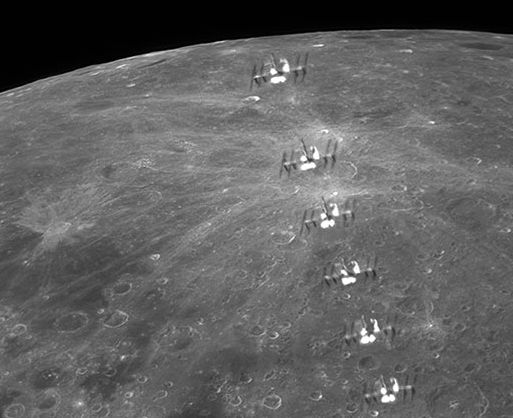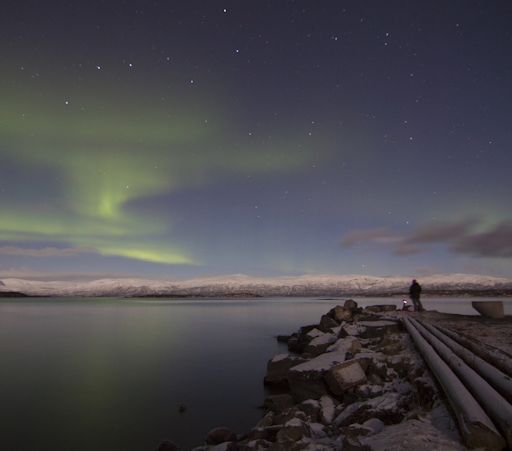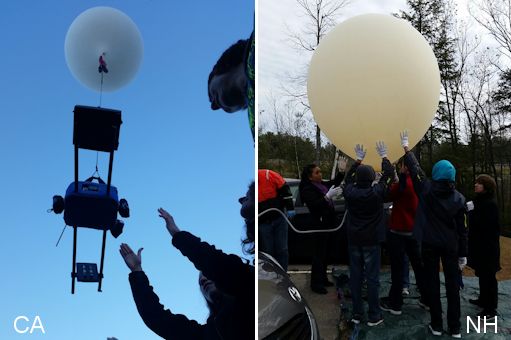Marianne's Heaven On Earth Aurora Chaser Tours Chasethelighttours.co.uk invites you to join them in their quest to find and photograph the Aurora Borealis. Experience the winter wonderland in the Tromsø Area. | | | SLIGHT UPTICK IN SOLAR ACTIVITY: Solar activity has been very low for more than a week. Growing sunspot AR2454 is breaking the quiet--but only a little. The active region is crackling with minor C-class solar flares. The explosions could intensify if the sunspot continues to grow. Solar flare alerts: text or voice FLY ME TO THE MOON: Observers of America's space program have often lamented that the International Space Station cannot go to the Moon. On Nov. 21st, it looks like it finally made the trip. Dennis Simmons sends this picture from Brisbane, Qld, Australia: 
Unfortunately, it only looks like the ISS has re-traced the steps of Apollo. The giant spaceship is still in Earth orbit. It did, however, pass in front of the Moon as seen by observers in parts of Australia. "The transit lasted just 0.49 seconds," says Simmons, who used a video camera to record the split-second passage. "This is a composite of video frames taken through a C9.25 telescope." Elsewhere in Brisbane, astrophotographer Tom Harradine also took a spectacular picture of the transit. "I caught the ISS passing by the crater Copernicus," he says. At the time of the transit, the ISS was 400 km from Earth and almost 400 thousand km from the Moon. So it still has a ways to go. For now, lunar transits are the next best thing to being there. Realtime Space Weather Photo Gallery AURORAS, FOR NO PARTICULAR REASON: Nov. 21st was a day of quiet space weather. There were no intense solar flares, no CMEs, and no geomagnetic storms. The auroras appeared anyway. Liselotte Kahns saw them over Sweden's Abisko National Park: 
"Despite the extremely low level of solar activity, Abisko's clear sky demonstrated a nice aurora display tonight," says Kahns. "[It's] a good illustration of why this place is rated as one of the best places on Earth to see auroras." Indeed, it is not unusual for auroras to appear over Abisko even when the forecast calls for no magnetic activity. Aurora tour guides and photographers naturally gravitate toward the Park because of its frequently-green skies. The reason is Abisko's location beneath Earth's persistent auroral oval. A gentle rain of solar wind electrons, guided to Earth by our planet's curved magnetic field, creates a polar ring of Northern Lights that intersects the latitude of Abisko, more often than not. Browse the realtime gallery for more sightings: Realtime Aurora Photo Gallery TRANSCONTINENTAL SPACE WEATHER BALLOON FLIGHT: On Nov. 21st, the students of Earth to Sky Calculus, in collaboration with Spaceweather.com and the University of New Hampshire, launched a pair of space weather balloons from opposite sides of the USA. Using cell phones to conduct a transcontinental countdown, they released the balloons at the same moment from California and New Hampshire: 
Flying simultaneously, the balloons ascended to the stratosphere, sampling X-rays and gamma-rays at altitudes of interest to aviation, space tourism, and climate science. The goal of the experiment is to investigate a curious difference in radiation, which the group discovered during a previous transcontinental flight in July 2015. During the summer, radiation levels in the stratosphere above New Hampshire were more than 25% higher than California, a surprisingly wide gap considering the relatively small difference in latitude between the two launch sites. The Nov. 21st flight will confirm and expand upon the findings from July. Update: Both payloads have parachuted back to Earth. The New Hampshire payload landed in Maine, and has since been recovered from the branches of a tall tree. The California payload landed in the Saline Valley, a desert area not far from Death Valley National Park. It will be recovered on Nov. 22nd. Stay tuned for results from the flight. Realtime Space Weather Photo Gallery
Realtime Noctilucent Cloud Photo Gallery
Realtime Meteor Photo Gallery Every night, a network of NASA all-sky cameras scans the skies above the United States for meteoritic fireballs. Automated software maintained by NASA's Meteoroid Environment Office calculates their orbits, velocity, penetration depth in Earth's atmosphere and many other characteristics. Daily results are presented here on Spaceweather.com. On Nov. 22, 2015, the network reported 21 fireballs.
(13 sporadics, 5 Leonids, 2 Northern Taurids, 1 alpha Monocerotid)  In this diagram of the inner solar system, all of the fireball orbits intersect at a single point--Earth. The orbits are color-coded by velocity, from slow (red) to fast (blue). [Larger image] [movies] Potentially Hazardous Asteroids ( PHAs) are space rocks larger than approximately 100m that can come closer to Earth than 0.05 AU. None of the known PHAs is on a collision course with our planet, although astronomers are finding new ones all the time. On November 22, 2015 there were 1636 potentially hazardous asteroids. Notes: LD means "Lunar Distance." 1 LD = 384,401 km, the distance between Earth and the Moon. 1 LD also equals 0.00256 AU. MAG is the visual magnitude of the asteroid on the date of closest approach. | | Cosmic Rays in the Atmosphere | | Situation Report -- Oct. 30, 2015 | Stratospheric Radiation (+37o N) | | Cosmic ray levels are elevated (+6.1% above the Space Age median). The trend is flat. Cosmic ray levels have increased +0% in the past month. | | Sept. 06: 4.14 uSv/hr (414 uRad/hr) | | Sept. 12: 4.09 uSv/hr (409 uRad/hr) | | Sept. 23: 4.12 uSv/hr (412 uRad/hr) | | Sept. 25: 4.16 uSv/hr (416 uRad/hr) | | Sept. 27: 4.13 uSv/hr (413 uRad/hr) | | Oct. 11: 4.02 uSv/hr (402 uRad/hr) | | Oct. 22: 4.11 uSv/hr (411 uRad/hr) | These measurements are based on regular space weather balloon flights: learn more. Approximately once a week, Spaceweather.com and the students of Earth to Sky Calculus fly "space weather balloons" to the stratosphere over California. These balloons are equipped with radiation sensors that detect cosmic rays, a surprisingly "down to Earth" form of space weather. Cosmic rays can seed clouds, trigger lightning, and penetrate commercial airplanes. Our measurements show that someone flying back and forth across the continental USA, just once, can absorb as much ionizing radiation as 2 to 5 dental X-rays. Here is the data from our latest flight, Oct. 22nd: 
Radiation levels peak at the entrance to the stratosphere in a broad region called the "Pfotzer Maximum." This peak is named after physicist George Pfotzer who discovered it using balloons and Geiger tubes in the 1930s. Radiation levels there are more than 80x sea level. Note that the bottom of the Pfotzer Maximim is near 55,000 ft. This means that some high-flying aircraft are not far from the zone of maximum radiation. Indeed, according to the Oct 22th measurements, a plane flying at 45,000 feet is exposed to 2.79 uSv/hr. At that rate, a passenger would absorb about one dental X-ray's worth of radiation in about 5 hours. The radiation sensors onboard our helium balloons detect X-rays and gamma-rays in the energy range 10 keV to 20 MeV. These energies span the range of medical X-ray machines and airport security scanners. | | The official U.S. government space weather bureau | | | The first place to look for information about sundogs, pillars, rainbows and related phenomena. | | | Researchers call it a "Hubble for the sun." SDO is the most advanced solar observatory ever. | | | 3D views of the sun from NASA's Solar and Terrestrial Relations Observatory | | | Realtime and archival images of the Sun from SOHO. | | | from the NOAA Space Environment Center | | | the underlying science of space weather | | 
